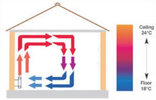Our house is built into the side of a hill, and at ground level to the front we have a downstairs hallway with front door, and access to the garage via an internal door. All other accommodation at one and two floors up. The original builders didn't fit a radiator down there, and for years we've been using a little portable panel heater - coiled radiant wire design, as far as I can tell, rated at 500w. It takes the chill off, but doesn't really warm the place.
We're getting a wall-mounted oil-filled radiator fitted, but trying to judge what rating to get. Want it to give more heat, but not go too high so that we're wasting money on a more expensive one that we don't need.
I'm told that the thermal oil in them makes them more efficient than the equivalent panel heater like ours, but if we go for a 500w oil-filled, will that be noticeably warmer than the current panel heater? Should we go for a 750w or 1kW?
We're getting a wall-mounted oil-filled radiator fitted, but trying to judge what rating to get. Want it to give more heat, but not go too high so that we're wasting money on a more expensive one that we don't need.
I'm told that the thermal oil in them makes them more efficient than the equivalent panel heater like ours, but if we go for a 500w oil-filled, will that be noticeably warmer than the current panel heater? Should we go for a 750w or 1kW?


